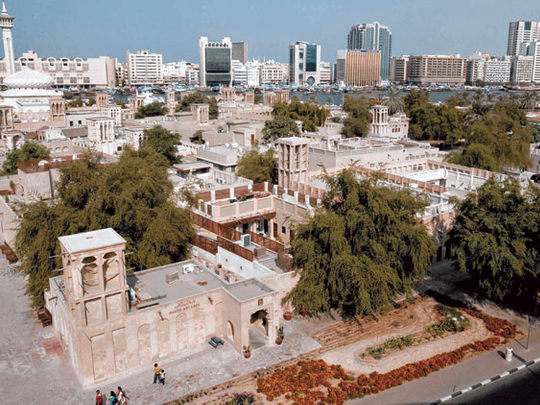
Dubai: Historic parts of Dubai along the Creek, including Al Shindagha, old souks and Al Bastakia, will be included in the preliminary list that will be submitted to Unesco for recognition as world heritage sites, a senior official told Gulf News.
Some other heritage sites including the Maliha archaeological site in Sharjah, Al Dour in Umm Al Quwain that goes back to the Hellenistic era, and a site with old barracks of the British army in Ras Al Khaimah also feature in the preliminary list, said Rashad Mohammad Bukhash, director of the Architectural Heritage Department at Dubai Municipality.
"We are currently working on submitting the list of six sites. These are in the preliminary tentative list and we can add more sites in later stages. These are being included mainly because of their cultural value," said Bukhash who is also chairman of the UAE Architectural Heritage Society.
December time-frame
The list will be submitted by December this year after which files for individual sites will be submitted.
"More sites can be added later. We have more than 20 sites which we plan to include at later stages. Like, in Jumeirah, we have an archaeological site that dates back to the 2nd Islamic century that we are thinking of registering and also Hatta village, which represents a typical traditional village."
Every emirate has identified the preservation of culture and heritage as a priority area. Dubai spends Dh5 million on the preservation and restoration of its historic sites.
Meanwhile, the municipality has announced that Dubai will host the 3rd International Architectural Conservation Conference and Exhibition from December 17 to 19. "The theme of the conference this year is ‘Architectural conservation: Present and future', and will gather international experts in the field of conservation-restoration to exchange expertise and new strategies for conserving historical zones and buildings, protecting heritage sites and developing the urban landscape in a sustainable manner," said Obaid Salem Al Shamsi, assistant director-general, Dubai Municipality.
Running alongside the conference will be an exhibition and the UAE Building Heritage Week — a new initiative featuring activities and competitions to honour heritage sites and buildings across all the emirates.
"The purpose behind the conference is to serve the professional conservation community involved in scientific research, education and training, architectural design, construction and field projects by providing them a platform to unify their energies for the cause."
Main criteria
Any building in Dubai that is 40 years old is evaluated by the Architectural Heritage Department after which the building is categorised.
The categorisation is based on the architectural and cultural value besides other aspects. A building that falls in category A, for instance, will have its original shape maintained and bear minimal changes.
Al Fahidi Fort, the oldest building in Dubai, falls under category A.
"In Dubai 45 of the 492 buildings that are listed as historic fall under this category," said Rashad Mohammad Bukhash, director of the Architectural Heritage Department at Dubai Municipality.
In category ‘B' buildings, the exteriors remain unchanged while the interiors may be changed. Several restaurants and hotels in Dubai are housed in buildings that fall under this category.
Not only is the UAE actively pursuing restoration and preservation of heritage buildings, they are also being used as models for new ones. Dubai, in fact, is planning to develop some districts with only traditional houses.











